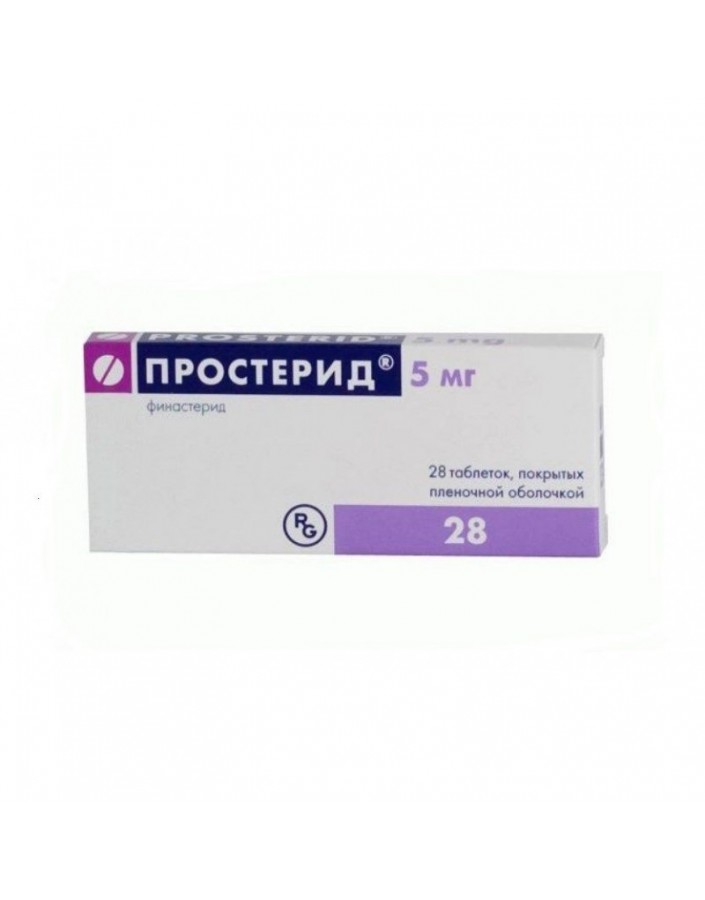




Security policy (edit with Customer reassurance module)

Delivery policy (edit with Customer reassurance module)

Return policy (edit with Customer reassurance module)
Composition and release form:
| Film Coated Tablets | 1 tab. |
| finasteride | 5 mg |
| Excipients: Magnesium stearate; talc; sodium starch glycolate (type A); pregelatinized starch; MCC; lactose monohydrate | |
| shell composition: titanium dioxide; macrogol 6000; hydroxypropylcellulose; hydroxypropylmethylcellulose, lactose monohydrate |
in blister pack of 14; in a pack of cardboard 1 or 2 packs.
Description of the dosage form:
Tablets, film coated, white or almost white in color, the shape of a rounded triangle, slightly biconvex, almost odorless, engraved with “RG” on one side.
Pharmacokinetics:
After ingestion is rapidly absorbed from the gastrointestinal tract. Bioavailability is about 80% and does not depend on food intake. After a single oral administration Cmaxin plasma, achieved in 1–2 hours. Plasma protein binding is about 90%. It is metabolized by the liver and excreted as metabolites by the kidneys (approximately 40%) and through the intestine (about 60%). T1/2 The drug is about 6 hours, in patients older than 70 years can be extended up to 8 hours.
Pharmacodynamics:
Synthetic 4-azasteroid compound, a competitive and specific inhibitor of 5-alpha reductase - an intracellular enzyme that turns testosterone into an active androgen - 5-dihydrotestosterone. The growth of prostate tissue and the development of BPH are due to the conversion of testosterone to dihydrotestosterone in the cells of the prostate gland. Under the influence of the drug, there is a significant decrease in the concentration of dihydrotestosterone in both plasma and gland tissue. Finasteride does not bind to androgen receptors. It inhibits the stimulating effect of dihydrotestosterone on the development of BPH, as a result, the severity of symptoms associated with BPH decreases.
It has no effect on plasma lipids and levels of cortisol, estradiol, prolactin, TSH, and thyroxin.
Indications:
Treatment of benign prostatic hyperplasia in order to reduce the size of the prostate gland; increasing the maximum rate of outflow of urine and reducing the symptoms associated with hyperplasia; reduce the risk of acute urinary retention and the associated likelihood of surgery.
Contraindications:
Hypersensitivity to finasteride or other components of the drug.
Side effects:
In some cases - gynecomastia, impotence, decreased libido, a decrease in the volume of ejaculate (the frequency of these side effects does not exceed 3-4% and decreases during treatment). In some cases, there was an increase in levels of LH, FSH and testosterone by about 10%, but these figures remained within normal limits.
Allergic reactions (angioedema of the lips, skin rash) are possible.
Dosage and administration:
Inside on 5 mg once a day, irrespective of meal. The duration of therapy to assess its effectiveness must be at least 6 months. In approximately 50% of patients, the disappearance of clinical symptoms occurred only during treatment for 12 months.
Special instructions:
Pregnant women should avoid contact with crushed or lost integrity of finasteride tablets, since the ability of the drug to suppress the conversion of testosterone to dihydrotestosterone can cause a disorder in the development of the fetal genital organs.
Before starting treatment, it is necessary to exclude diseases that have symptoms similar to those of BPH, such as prostate cancer, infectious prostatitis, urethral stricture, hypotonic bladder and a number of changes in the urinary system that occur in certain diseases of the nervous system.
With caution, the drug is prescribed to patients with impaired liver function.
Since there is a decrease in prostate-specific antigen when using finasteride, periodically during the treatment process, patients should be examined to exclude prostate cancer.